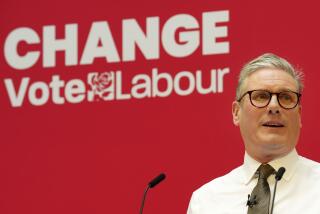ELECTIONS : THE BATTLE OF BRITAIN
- Share via
The British will be voting Thursday in what may be their most crucial election in a dozen years. The vote will amount to a national referendum on the performance of the Conservative Party, which came to power in 1979 under Prime Minister Margaret Thatcher.
ISSUES: The economy is the main topic, closely trailed by concerns such as taxes for social services, the national health service and free education. The Tories (Conservatives) have privatized industries and plumped for a free-market economy. They accuse the opposition Labor Party of wishing to return to socialism. Like the United States under the Republican Ronald Reagan Administration, Britain appeared to prosper in the 1980s. But, like many of the key industrial nations, Britain has plunged into a deep recession.
For the record:
12:00 a.m. April 9, 1992 For the Record
Los Angeles Times Thursday April 9, 1992 Home Edition Part A Page 3 Column 5 Metro Desk 1 inches; 19 words Type of Material: Correction
Map of Britain--A map of the British Isles in Saturday’s editions erred in placing the English-Scottish border too far to the north.
THE SYSTEM: A national election must be held at least once every five years; its timing is at the prime minister’s discretion. (Prime Minister John Major, facing a July deadline, called for the current election just after announcing his proposed, tax-cutting budget.) While the 32.5 million British voters--those age 18 and older who are eligible--cast ballots only for their local member of Parliament, they are strongly influenced by the national party leadership. The British vote for a member of Parliament in each of 651 constituencies; parliamentary candidates win by receiving the most votes. The party then that musters a parliamentary working majority--overall, or in a coalition with minor parties--is chosen by the queen to govern the nation; the party leader assumes the post of prime minister and forms an administration, with Cabinet members chosen from Parliament.
FORECAST: The public opinion polls have varied but most show Labor with a slight lead, although not enough for an overall majority in Parliament. The Tories suggest that their popularity will increase as Election Day approaches and that they will gain a reduced but absolute majority. Labor disputes this and says it will win clearly, though the party would need an 8% swing to achieve this. This has not occurred since 1945.
PROSPECTS: Some experts are predicting a deadlocked Parliament, in which neither major party has an absolute majority. In this case, the leading party could be asked to form a minority government. But it would risk losing a vote of confidence in Parliament, prompting a new election. The leading party also could attempt to form a coalition government with the third-party Liberal Democrats. But this scenario, it is widely believed, would result in an unstable government; it would be forced to make compromises that could make it ineffectual, as is the case in other European countries, governed under various forms of proportional representation.
The U.S.-British Connection
Shifts between parties in the United States and Britain have been remarkably similar in the last three decades: (Dates signify elections) BRITAIN: Labor: Oct. ‘64: Wilson Labor: Mar. ‘66: Wilson Conservative: Jun. ‘70: Heath Labor: Feb. ‘74: Wilson Labor: Oct. ‘74: Wilson Labor: Mar. ‘76: Callaghan Conservative: May. ‘79: Thatcher Conservative: May. ‘83: Thatcher Conservative: Jun. ‘87: Thatcher Conservative: Nov. ‘90: Major (Change in leadership without election)
UNITED STATES: Democratic: Nov. ‘64: Johnson Republican: Nov. ‘68: Nixon Republican: Nov. ‘72: Nixon Republican: Aug. ‘74: Ford (Change in leadership without election) Democratic: Nov. ‘76: Carter Republican: Nov. ‘80: Reagan Republican: Nov. ‘84: Reagan Republican: Nov. ‘88: Bush
Leading The Charge
JOHN MAJOR: Prime minister Conservative Party THE CANDIDATE: A man from modest roots in London . . . 49 . . . described by supporters as being the caring face of the Conservative Party . . . critics call him “a gray man in a suit” . . . served as chancellor of the exchequer . . . worked as a banker. PARTY PLATFORM: Party generally calls for lower taxes and reduced public spending to encourage investment and economic growth.
NEIL KINNOCK: Member of Parliament (Opposition leader) Labor Party THE CANDIDATE: Born 50 years ago in Wales, the only son of a disabled miner and a district nurse . . . graduated from University College in Cardiff . . . married a woman whose roots in the party ran as deep as his . . . by the time he was 28, was a member of Parliament . . . has been opposition leader since 1983. PARTY PLATFORM: Believes in more government regulation to ensure fairness in the market; favors higher taxes for the wealthy.
PADDY ASHDOWN: Member of Parliament (Party Leader) Liberal Democrats THE CANDIDATE: A former Royal Marine Commando . . . 51 . . . possesses a vigorous manner and a clean-cut image . . . recently admitted to conducting a five-month affair with his secretary . . . saw his public popularity rise after personal scandal.
PARTY PLATFORM: Favors public spending to create new jobs, as well as raising taxes; as the nation’s third party, pushing for proportional representation in Parliament.
THE POWER IN PARLIAMENT
Voters go to the polls in England, Scotland, Wales, and Northern Ireland on Thursday in a wide-open national election to choose members of the House of Commons. The prime minister is the leader of the majority party in the Commons. At right, the current breakdown of the 651-member House of Commons. Conservative: 57% Labor: 35% Liberal Democrat: 3% Others: 5%
CENTRAL ISSUE: The Economy
Inflation: 9.4%
Expected budget deficit: $48.4 billion
Sources: Facts on File, British Consulate, Political Handbook of the World, the Economist
More to Read
Sign up for Essential California
The most important California stories and recommendations in your inbox every morning.
You may occasionally receive promotional content from the Los Angeles Times.













